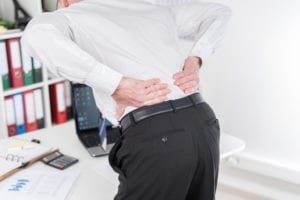Written by Jessica Patella, ND. Both pulsatile and minimal dry cupping were effective at 4 weeks; however, after 12 weeks of treatment only pulsatile cupping offered pain relief for participants suffering from chronic back pain.
 Lower back pain is one of the most common reasons a person seeks medical help 1. Worldwide low back pain causes more disability than any other condition 2,3. It is estimated that 5-10% of all people that suffer from low back pain will develop chronic lower back pain, accompanied by treatment costs, sick leave and decreased quality of life 1,2. Due to the negative side effects of over the counter NSAIDs on the stomach and kidneys, many turn to alternative options 1,2. Recent research has found pulsatile cupping and minimal cupping beneficial in helping those that suffer from lower back pain 2.
Lower back pain is one of the most common reasons a person seeks medical help 1. Worldwide low back pain causes more disability than any other condition 2,3. It is estimated that 5-10% of all people that suffer from low back pain will develop chronic lower back pain, accompanied by treatment costs, sick leave and decreased quality of life 1,2. Due to the negative side effects of over the counter NSAIDs on the stomach and kidneys, many turn to alternative options 1,2. Recent research has found pulsatile cupping and minimal cupping beneficial in helping those that suffer from lower back pain 2.
Cupping is a method of treatment used in Traditional Chinese Medicine and is typically used for musculoskeletal disorders 4. Traditionally a glass cup is used and applied to the region of pain to increase blood flow to the area. In this study, a modern technology was used called pulsatile cupping, where a mechanical device creates a negative pressure or vacuum inside a silicone cup with a pump 2,5. The objective of this study was used to look at both the effectiveness of this modern form of cupping and to determine if different strengths of vacuum pressure made a difference in pain relief.
A total of 110 participants (mean age 49 y/o) with chronic back pain were randomly assigned to one of three groups:
- Pulsatile Cupping: 8 cupping sessions, 8-minutes each in 4-weeks (Hexateuch PST 30 device, negative pressure -150 to -350 mbar, 2 second suction) (n=37).
- Minimal Cupping: 8 cupping sessions, 8-minutes each in 4-weeks (Hexateuch PST 30 device, negative pressure -70 mbar, 2 second suction) (n=36).
- Control group: No cupping (n=37).
All groups were allowed to use paracetamol (max dosage 4 X 500 mg/day) as needed as a rescue medication for pain.
The Visual Analog Scale (VAS) was used to measure pain (0=no pain, 100=maximum pain). The following results were observed after 4-weeks:
- Pulsatile Cupping: average VAS was 34.9 (95%CI: 28.4; 41.2)
- Minimal Cupping: average VAS was 40.4 (95%CI: 34.2; 46.7)
- Control group: average VAS was 56.1 (95%CI: 49.8; 62.4) Group (p<0.001) and between the Minimal Cupping Group and Control Group (p=0.001) 2.
This resulted in a statistically significant difference between the Pulsatile Group and Control Group (p<0.001) and between the Minimal Cupping Group and Control Group (p=0.001) 2. A study limitation was the lack of blinding in the control group.
After 12-weeks participants were assessed on the VAS again to determine how long cupping may be effective. After 12-weeks the VAS score was only lower for the Pulsatile Group vs Control group (15.1 difference, 95%CI (3.1; 27.1) p=0.014) 2. It is also important to note that no serious adverse events were observed 2.
In conclusion, both pulsatile cupping and minimal pulsatile cupping were effective with chronic low back pain after 4-weeks of treatment compared to a control group; however, only pulsatile cupping was helpful in reducing pain after 12 weeks compared to the control group 2. These results are helpful in understanding the effects of modern technology pulsatile cupping. Further research is recommended to ascertain real life effects in clinical care routine conditions to further understand its mode of action and usefulness.
Source: Taut, M., A. Ullmann, M. Ortiz, G. Rotter, S. Bunting, M. Cree, F. Lots, S. Roll, and B. Bronchus. “Pulsatile dry cupping in chronic low back pain–a randomized three-armed controlled clinical trial.” BMC complementary and alternative medicine 18, no. 1 (2018): 115.
© The Author(s). 2018 Open Access This article is distributed under the terms of the Creative Commons Attribution 4.0 International License (http://creativecommons.org/licenses/by/4.0/) Creative Commons license The Creative Commons Public Domain Dedication waiver (http://creativecommons.org/publicdomain/zero/1.0/) applies to the data made available in this article, unless otherwise stated.
Click here to read the full text study.
Posted April 1, 2019.
References:
- German Medical Association NAoSHIPK, Association of Scientific Medical Societies (AWMF) National Disease Management Guidelines, Low Back Pain. 1st edition ed2011.
- Teut M, Ullmann A, Ortiz M, et al. Pulsatile dry cupping in chronic low back pain – a randomized three-armed controlled clinical trial. BMC Complement Altern Med. 2018;18(1):115.
- Hoy D, March L, Brooks P, et al. The Global Burden of Low Back Pain: Estimates from the Global Burden of Disease 2010 Study. Annals of the rheumatic diseases. 2014;73(6):968-974.
- Mehta P, Dhapte V. Cupping therapy: A prudent remedy for a plethora of medical ailments. J Tradit Complement Med. 2015;5(3):127-134.
- Teut M, Kaiser S, Ortiz M, et al. Pulsatile dry cupping in patients with osteoarthritis of the knee – a randomized controlled exploratory trial. BMC Complement Altern Med. 2012;12:184.

